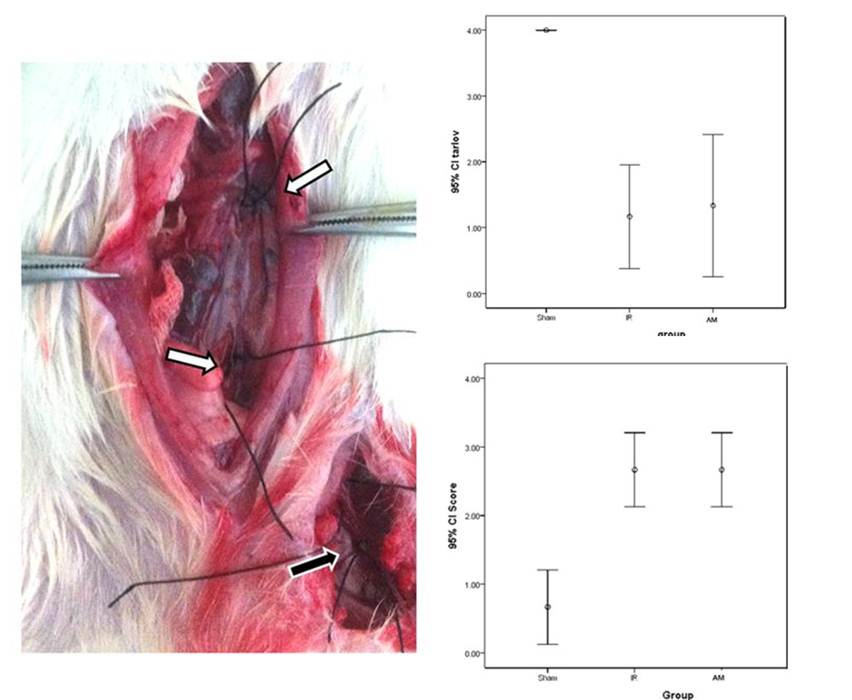초록접수 현황
| 14F-046 | 포스터 발표 |
A Simple Method of Direct Delivery of Pharmacologic Agents into the Aortic Segment in Rat Model of Spinal Cord Ischemia-reperfusion Injury
강신광, 강민웅, 유재현, 임승평, 이연주, 정유영, 나명훈
충남대학교 의과대학 흉부외과학교실
Background : Paraplegia is a devastating complication following operations of thoraco-abdominal aorta. Experimental models of spinal cord ischemia have been developed in various animals with variable reproducibility. The purpose of the study is to develop a simple method of direct delivery of pharmacologic agents into the occluded segment of the aorta in rat model of spinal cord ischemia-reperfusion injury.
Methods : Twelve SD rats(250-300g) were randomly divided into three groups: the sham S group(n=4), the ischemia-reperfusion IR group(n=4), the administration model AM group(n=4). The S group underwent sham operation without intervention. The IR group underwent femoral artery cannulation and midline laparotomy followed by a 60 minute of infra-renal aortic cross-clamp and supra-bifurcational aortic cross-clamp simultaneously. The AM group underwent aortic cross-clamp as same as the IR group, and carbon black ink was administrated into the occluded segment of the aorta for the visualization of delivery of targeted agents into the occluded segment of the aorta. Neurologic evaluation for the locomotor function was done according to the modified Tarlov score, and the spinal cord was harvested for histopathologic examinations after 48 hours reperfusion.
Results : There was no mortality. Spinal cord ischemia-reperfusion model was induced with good reproducibility in IR group and AM group. The Tarlov score was 4.0 in sham group, 1.17 ± 0.75 in IR group, 1.33 ± 1.03 in AM group (p<0.05). HE stain and Luxol-fast stain showed significant ischemic damage in the IR group and AM group than the S group. Intravascular administration of dye was well visualized at operation in AM group.
Conclusion : This study demonstrated a simple method of direct delivery for targeted material into the spinal cord in rats with spinal cord ischemia-reperfusion injury. This model may be useful to examine various materials for the effect of spinal cord ischemia-reperfusion model in rats.
Methods : Twelve SD rats(250-300g) were randomly divided into three groups: the sham S group(n=4), the ischemia-reperfusion IR group(n=4), the administration model AM group(n=4). The S group underwent sham operation without intervention. The IR group underwent femoral artery cannulation and midline laparotomy followed by a 60 minute of infra-renal aortic cross-clamp and supra-bifurcational aortic cross-clamp simultaneously. The AM group underwent aortic cross-clamp as same as the IR group, and carbon black ink was administrated into the occluded segment of the aorta for the visualization of delivery of targeted agents into the occluded segment of the aorta. Neurologic evaluation for the locomotor function was done according to the modified Tarlov score, and the spinal cord was harvested for histopathologic examinations after 48 hours reperfusion.
Results : There was no mortality. Spinal cord ischemia-reperfusion model was induced with good reproducibility in IR group and AM group. The Tarlov score was 4.0 in sham group, 1.17 ± 0.75 in IR group, 1.33 ± 1.03 in AM group (p<0.05). HE stain and Luxol-fast stain showed significant ischemic damage in the IR group and AM group than the S group. Intravascular administration of dye was well visualized at operation in AM group.
Conclusion : This study demonstrated a simple method of direct delivery for targeted material into the spinal cord in rats with spinal cord ischemia-reperfusion injury. This model may be useful to examine various materials for the effect of spinal cord ischemia-reperfusion model in rats.

책임저자: 나명훈
충남대학교 의과대학 흉부외과학교실
연락처 : 강신광, Tel: 042-280-8379 , E-mail : cskkwang@gmail.com




















